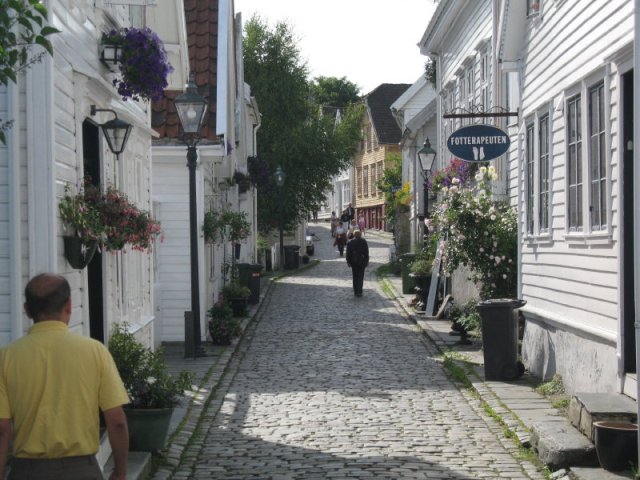Stavanger (Norway) : While the Preikestolen (Pulpit Rock) and the Kejarag, a large stone wedged between two mountains about 1000 metres above the fjord, are one the prominent tourist destinations, during the summer months in the Stavanger area, but a visitor is more than impressed by the wooden houses in Old Stavanger, said to have been built at the end of 1700 and during the 1800s that still retain their pristine charm.

A walk along the narrow cobbled streets lined by the old houses still wearing their coat of white paint and red sloping roofs, in the shadow of ultra modern apartments overlooking them, one can not but be impressed by the keen interest shown by their residents in adding colour to the white wooden houses.
Colourful flower plants can be seen on the windows and attached to the walls, while inside the windows one gets to see rare artifacts and other colourful showpieces.
It is obvious that a number of tourists visiting the city make it a point to enjoy the area from the fact that one can see ‘Please do not disturb’ signs on the windows of a couple of the houses requesting the visitors not to disturb their privacy.
However, a number of art galleries and other small shops welcome the visitors, as does the cannery museum, signifying the time when canning of fish was the most important industry in the region.
To a visitor from India though the cobbled streets may not ring any bells, but the big stone slabs that one sees along the streets remind them of the old villages of Uttarakhand and Himachal Pradesh, where similar big slabs can be seen outside all the houses and along the pathways in the villages.
However, what stand out at Old Stavanger are the old-time street light pillars, which have stood the years that have gone by.
Stavanger is the third largest urban zone and metropolitan area in Norway, courtesy the 1960s, when exploratory oil-drilling in the North Sea changed the situation for the city.
It is located close to the oil-fields, and with its good harbour and plane-connections was well-positioned to take advantage of the increased activity. After petroleum exploration and production became the most important business sector in the Stavanger area during the mid-1970s, business and cultural climate has changed considerably.
The largest oil company in Stavanger is mainly state-owned oil company who have their headquarters located in the suburban area of Forus, located between neighboring Sandnes and Stavanger.
Incidentally, Stavanger counts its official founding year as 1125, the year the Stavanger cathedral was completed and which can still be seen in all its regal splendour. It is said to have retained its original design and has been in continuous usage.
Old Stavanger, or Straen as the area is also known, has northern Europe’s best preserved wooden buildings. Said to be numbering about 173, the protected and restored wooden buildings are said to have been constructed at the end of 1700 and during the 1800’s. Most of the houses are painted white, but offers variety in size, style and design.
There is, however, divided opinion about the age of the buildings. Villa Blidensol Upper Strand Street 112 is often cited as the likely oldest house, after the Cathedral and the Bishop’s Chapel.
It was probably built in the early 1700’s or late 1600’s . Of the sites in Straen, it is said that some were destroyed by fire in 1766 and 1768 and of the buildings that exist today some could be younger than those originally listed. But there are a few houses that dates back further than 1768.
Old Stavanger was the Year of Architecture 1975, designated byUNESCO as one of the most valuable historic towns in Norway together with the Roros.
Stavanger has received several awards for the preservation of the Old Town. The houses are partly private and partly in the municipal ownership.
If old timers are to be believed it is said that the then richest people lived at the head of the bay, and that this was mainly shipowners and merchants, and that wealth and social status decreased the farther away one lived from the harbour.
Photo: Wikimedia
A journalist with over 40 years of experience, Jagdish Bhatt was Editor, Hill Post (Uttarakhand).
Jagdish had worked with India’s leading English dailies, which include Times of India, Indian Express, Pioneer and several other reputed publications. A highly acclaimed journalist, he was a recipient of many awards
Jagdish Bhatt, aged 72, breathed his last on 28th August 2021 at his Dehradun residence.


